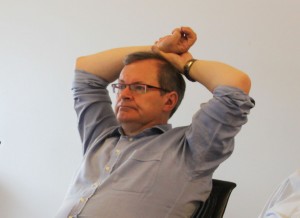Strategic planning has become central to organising and prioritising the worldwide programme in particle physics. In Europe, the process of developing an update to the “European Strategy for Particle Physics” is under way, while in Japan, KEK is updating their roadmap and in the US, the Snowmass workshop on the future of the US programme is being organised for next year. The future course of the ILC and, more generally, for a linear collider will be heavily influenced by the results of these planning exercises. As a result, we have put together a set of input documents for the update of the European Strategy open symposium that will take place in Krakow, Poland from 10 to 12 September.
Juan Fuster wrote a Research Director’s Report on the coming open meeting in Krakow where he discusses the seven linear collider submissions. Today, I want to emphasise specifically a couple of points that we made in the submission from the Executive Committee (EC) of the GDE, a note that served as a cover letter for the ILC submissions.
At this point in time, we are deep into the process of putting together the final deliverable of the GDE, our design for a 500-GeV electron-positron collider based on superconducting RF technology for the main linac. Our main focus has been to optimise our design for cost, performance and risk of a 500-GeV machine and present it in our Technical Design Report. A crucial underlying feature that should not get lost by presenting a specific design for the ILC is the underlying “flexibility” of such a facility.
This importance of flexibility has been emphasised in the cover letter, making the powerful point how a broad programme of important precision measurements related to the Higgs and other phenomena will be possible with the ILC.
Excerpting from this submission, the cover letter states:
“A characteristic of linear colliders in general and the ILC in particular is the high degree of flexibility of operation. While the design of the ILC has been optimized for operation at 500 GeV, scanning down to low energies, for example the regime around 200 GeV and upwards which is of interest for the newly discovered Higgs-like object at LHC, is rather straight-forward.”
It goes on to point out the broad flexibility to pursue physics goals beyond the scope of the TDR:
“Further flexibility is demonstrated by optional running modes not costed or designed in detail in the TDR but which can clearly be implemented relatively easily given strong user interest and consensus. Such options include electron-electron collisions, operation as a gamma‐gamma collider and operation at the Z pole with luminosity significantly higher than was possible at LEP, the so-called “GigaZ” option.”
And finally, and more specifically, the cover letter points how this flexibility results in the broad capability of the ILC to address specific questions:
“The most powerful and unique property of the LC is its flexibility. It can be tuned to well-defined initial states, including polarisation, allowing numerous model independent measurements, from the Higgs threshold to multi-TeV operation, as well as the possibility of unprecedented precision at the Z-pole (GigaZ). Furthermore, the relative simplicity of the production processes and final state configurations makes complete and extremely accurate reconstruction and measurement possible. The envisioned physics programme includes precision measurements of many Higgs decay widths, some of which are uniquely accessible at the LC (cc, gg, the invisible mode and the full width), decisive tests of the spin-parity properties of the Higgs candidate, and determinations of the top-Higgs and trilinear Higgs self couplings, also uniquely accessible at the LC. For a LC operating up to and beyond 500 GeV, the complete SM, including Higgs, top quark and VV interactions can be studied, both at tree level and through quantum corrections. In addition to precision tests of minimal EWSB and its Higgs boson(s), the LC also reaches well into new physics territory, where the potential exists to discover dark matter, aspects of supersymmetry, evidence for composite Higgs, or to test other well motivated BSM ideas. The physics reach of the LC is essentially limited by statistics, not systematics. Its discovery reach exceeds that of the LHC at any integrated luminosity in many cases, and discoveries of new particles or interactions at either machine can be subjected to further precision analysis at the LC to reveal deeper structures of the nature.”
As we particle physicists begin to grapple with the physics implications of the discovery of a Higgs-like particle at the LHC, as well as other discoveries that will almost certainly soon follow, the flexibility of the ILC becomes perhaps its greatest asset. It is not much of an exaggeration to assert that whatever physics emerges from the LHC, the ILC will be capable of powerfully focusing on and exploiting that science.



Recent Comments